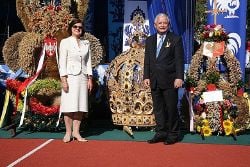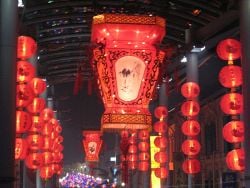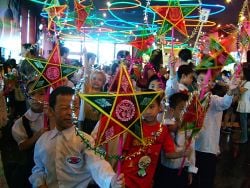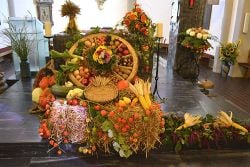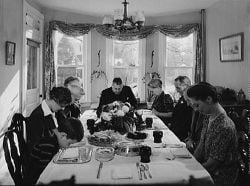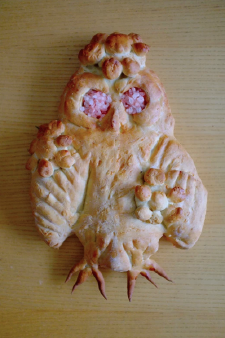Harvest festival
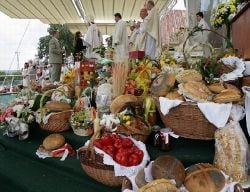
A harvest festival, also Thanksgiving, is an annual celebration that occurs around the time of the main harvest of a given region. These festivals typically feature feasting, both family and public, with foods that are drawn from crops that come to maturity around the time of the festival. Ample food and freedom from the necessity to work in the fields are two central features. Eating, merriment, contests, and music are common features of harvest festivals around the world.
Harvest festivals generally included a religious or spiritual component in early times, with offerings made to thank the gods or goddesses for the bounty received. Although the religious aspect may be less apparent today, the spirit of gratitude and sharing the harvest with the whole community, and even beyond to those in need, remains a central theme of contemporary celebrations.
History and traditions
"Harvest" comes from the Old English word hærf-est meaning "autumn" (the season), the "period between August and November." "The harvest" came to also mean the activity of reaping, gathering, and storing grain and other grown products during the autumn, and also the grain and other grown products themselves.[1]
Cultures from ancient times have celebrated the harvest. Grateful for the bounty, they often offered tribute to their gods and goddesses in the form of the first harvested fruits, grains, or meat. A feast was often held to celebrate, with the whole community invited to participate.
The Romans held feasts in honor of Ceres, the goddess of cereals; the Greeks paid tribute to the goddess Demeter; the Ancient Egyptians erected a statue of Min, the god of vegetation and fertility, on the harvested fields. It was important to these people to both thank the god or goddess for their generosity in providing a bountiful harvest and to make offerings to prepare for the coming year's new growth.
Many customs and traditions related to the harvest originate in the animistic belief in spirits such as the "corn mother" or "rice mother" who cause the cereal crops to grow successfully. Since these crops form the staple diet in most cultures, the construction of a figure, such as a corn dolly, from the last sheaf harvested was often incorporated into the celebration.
Harvest festivals generally include a feast from the newly harvested crops to which all are invited; singing and dancing; contests; and parades of decorated horse-drawn carts or tractors.
Around the World
Asia
Harvest festivals in Asia include the Chinese Mid-Autumn Festival (ä¸ç§ç¯), one of the most widely spread harvest festivals in the world. The festival is held on the 15th day of the 8th month of the lunar calendar with a full moon at night, corresponding to mid-September to early October of the Gregorian calendar.[2]
This festival is celebrated notably by the Chinese and Vietnamese people,[3] however similar festivals of Chuseok (in Korea) and Tsukimi (in Japan) are also held at this time.
The festival celebrates three fundamental concepts that are closely connected:
- Gathering, such as family and friends coming together, or harvesting crops for the festival. It is said the moon is the brightest and roundest on this day which means family reunion. Consequently, this is the main reason why the festival is thought to be important.
- Thanksgiving, to give thanks for the harvest, or for harmonious unions
- Praying (asking for conceptual or material satisfaction), such as for babies, a spouse, beauty, longevity, or for a good future
Traditions and myths surrounding the festival are formed around these concepts, although they have changed over time due to changes in technology, science, economy, culture, and religion.[4]
The Chinese have celebrated the harvest during the autumn full moon since the Shang dynasty (c. 1600â1046 B.C.E.).[4] although a festival celebration only started to gain popularity during the early Tang dynasty (618â907 C.E.). Legend explains that Emperor Xuanzong of Tang started to hold formal celebrations in his palace after having explored the Moon-Palace.[4] For the Baiyue, indigenous non-Chinese peoples, the harvest time commemorated the dragon who brought rain for the crops.[3]
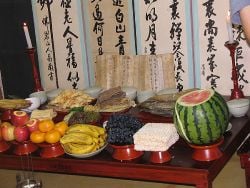
Making and sharing mooncakes, a rich pastry typically filled with sweet-bean or lotus-seed paste, are traditionally eaten during the festival. is one of the hallmark traditions of this festival. In Chinese culture, a round shape symbolizes completeness and reunion. Thus, the sharing and eating of round mooncakes among family members during the week of the festival signifies the completeness and unity of families.
A notable part of celebrating the holiday is the carrying of brightly lit lanterns, lighting lanterns on towers, or floating sky lanterns. Traditionally, the lantern has been used to symbolize fertility, and functioned mainly as a toy and decoration. But today the lantern has come to symbolize the festival itself.[4]
The Mid-Autumn festival is named "Tết Trung Thu" in Vietnamese. It is also known as Children's Festival because of the event's emphasis on children.[5] In its most ancient form, the evening commemorated the dragon who brought rain for the crops. Celebrants would observe the moon to divine the future of the people and harvests. Eventually the celebration came to symbolize a reverence for fertility, with prayers given for bountiful harvests, increase in livestock, and human babies. Over time, the prayers for children evolved into a celebration of children.[3]
The Japanese equivalent is the moon viewing festival, o-tsukimi. This is a time for people to picnic and drink sake under the full moon to celebrate the harvest.
The Korean festival of Chuseok (ì¶ì; ç§å¤), literally "Autumn eve", also celebrated at the full moon, is a major harvest festival and a three-day holiday in both North Korea and South Korea . As a celebration of the good harvest, Koreans visit their ancestral hometowns and share a feast of Korean traditional food such as songpyeon (ì¡í¸) and rice wines such as sindoju and dongdongju.
Europe
In Austria and Germany Erntedankfest (Harvest Thanksgiving) is celebrated traditionally on the first Sunday after Michaelmas, which is September 30 or later. Today, Protestant and Catholic churches recommend celebrating on the first Sunday in October.
In Catholic parts of French-speaking Switzerland, they celebrate Bénichon. It is a combined harvest festival, thanksgiving, and Rindya, the day when the animals are brought back from the high altitude pastures in the Alps and therefore when all villagers return. The celebration usually includes a feast with a seven-course menu.
In Paganism and Wicca, the holiday of the autumnal equinox, called Harvest Home, Mabon, the Feast of the Ingathering, Meán Fómhair or Alban Elfed (in Neo-Druid traditions), is a modern celebration of thanksgiving for the fruits of the earth. It is also a recognition of the need to share them to secure the blessings of the Goddess and the God during the coming winter months. The name Mabon was coined by Aidan Kelly around 1970 as a reference to Mabon ap Modron, a character from Welsh mythology.[6]
North America
In North America, Canada and the US each have their own Thanksgiving celebrations in October and November.
In the United States, Thanksgiving is celebrated on the fourth Thursday in November, at the end of the harvest season, as an annual Federal holiday. Traditionally, it is a time to give thanks for the harvest and express gratitude in general for one's material and spiritual possessions.
Thanksgiving dinner usually serves as a gathering of family members and friends. It is a day for feasting and watching football games, parades, and television specials. Thanksgiving is now primarily identified as a secular holiday, albeit of historical, legendary, and symbolic significance related to the deliverance of the English settlers by Native Americans after the brutal winter at Plymouth, Massachusetts.
In Canada, Thanksgiving, or Thanksgiving Day (Canadian French: Jour d'action de grâce), occurs on the second Monday in October. It is an annual holiday to give thanks at the close of the harvest season. Although some people thank God for this bounty, today the holiday is mainly considered secular.
The history of Thanksgiving in Canada goes back to the explorer, Martin Frobisher, who was seeking a northern passage to the Pacific Ocean. Frobisher's Thanksgiving was not for harvest but homecoming; having safely returned from his search for the Northwest Passage, avoiding the later fate of Henry Hudson and Sir John Franklin. In the year 1578, he held a formal ceremony in what is now the province of Newfoundland and Labrador, to give thanks for surviving the long journey.
Frobisher's feast was one of the first Thanksgiving celebrations in North America, although celebrating the harvest and giving thanks for a successful bounty of crops had been a long-standing tradition before the arrival of Europeans.
Native Americans had organized harvest festivals, ceremonial dances, and other celebrations of thanks for centuries. Today, these festivals, giving thanks to the Great Spirit and to nature for the harvest from crops, continue to be celebrated in homes, at Pow wows, and on reservations.[7]
United Kingdom
In the United Kingdom, thanks have been given for successful harvests since pagan times. These festivals, known as Harvest Festival, Harvest Home, Harvest Thanksgiving, or Harvest Festival of Thanksgiving, are traditionally held on the Sunday nearest to the Harvest Moon, which is the full moon that occurs closest to the autumn equinox (September 22 or 23). The celebrations on this day usually include singing hymns, praying, and decorating churches with baskets of fruit and food.
In many parts of England, tenants were bound to present freshly harvested wheat to their landlords on or before the first day of August. In the Anglo-Saxon Chronicle, where it is referred to regularly, it is called "the feast of first fruits." The blessing of first fruits was performed annually in both the Eastern and Western Churches on the first or the sixth of August (the latter being the feast of the Transfiguration of Christ).
In medieval times the feast was sometimes known in England and Scotland as the "Gule of August," but the meaning of "gule" is unclear. Ronald Hutton suggests that it is merely an Anglicization of Gŵyl Awst, the Welsh name of the "feast of August."[8]
An early harvest festival used to be celebrated at the beginning of the harvest season on August 1, called Lammas, meaning "loaf Mass." On this day it was customary for farmers to bring to church a loaf made from the new crop, which began to be harvested at Lammastide, which falls at the halfway point between the summer Solstice and autumn Equinox. These loaves were given to the local church as the Communion bread during a special service thanking God for the harvest. The Latin prayer to hallow the bread is given in the Durham Ritual. After the loaf was blessed the lammas bread might be employed afterwards in protective rituals.[9] This custom ended at the time of King Henry VIII, when he broke away from the Catholic Church, and the harvest celebration moved to the end of the harvest season.
By the sixteenth century a number of customs were firmly established around the gathering of the final harvest. They include the reapers accompanying a fully laden cart; a tradition of shouting "Hooky, hooky"; and one of the foremost reapers dressing extravagantly, acting as "lord" of the harvest and asking for money from the onlookers. A play by Thomas Nashe, Summer's Last Will and Testament, (first published in London in 1600 but believed to have been first performed in October 1592 at Croydon) contains a scene which demonstrates several of these features.
At this Harvest Supper, celebrated on Michaelmas Day, often a goose stuffed with apples was served. Another widespread tradition was the distribution of a special cake to the celebrating farm workers. A prose work of 1613, predating the Reformation, refers to this practice. A corn dolly, made from the last sheaf of corn harvested, often had a place of honor at the banquet table, and was kept until the following spring.
The modern British tradition of celebrating Harvest Festivals in churches began in 1843, when the Reverend Robert Hawker invited parishioners to a special thanksgiving service at his church at Morwenstow in Cornwall. Victorian hymns such as We plough the fields and scatter, Come, ye thankful people, come, All things bright and beautiful and the addition of Dutch and German harvest hymns in translation helped popularize his idea of harvest festival, and spread the annual custom of decorating churches with home-grown produce for the Harvest Festival service. Another early adopter of the custom as an organized part of the Church of England calendar was Rev Piers Claughton at Elton, Huntingdonshire.[10]
Until the twentieth century, most farmers celebrated the end of the harvest with a big meal called the harvest supper, to which all who had helped in the harvest were invited. It was sometimes known as a "Mell-supper," after the last patch of corn or wheat standing in the fields which was known as the "Mell" or "Neck." Cutting it signified the end of the work of harvest and the beginning of the feast.
Nowadays the festival is held at the end of harvest, which varies in different parts of Britain. People bring in produce from the garden, the allotment or farm. The food is often distributed among the poor and senior citizens of the local community, or used to raise funds for the church, or for charity. Sometimes neighboring churches will set the Harvest Festival on different Sundays so that people can attend each other's thanksgivings.
Jewish celebration of Sukkot
Jews celebrate the week-long harvest festival of Sukkot in the autumn. Coming as it does at the completion of the harvest, Sukkot is regarded as a general thanksgiving for the bounty of nature in the year that had passed. The holiday is a particularly joyous one, in which Gentiles as well as Jews are invited to participate.
According to the biblical books of Exodus and Deuteronomy, Sukkot had an agricultural origin. It was known, among other titles, as the "Feast of Ingathering" and was to be held "at the end of the year when you gather in your labors out of the field" (Ex. 23:16) and "after you have gathered in from your threshing-floor and from your winepress" (Deut. 16:13). Other biblical traditions, however, associate the holiday with the period of the Israelites' wandering in the wilderness, when they lived and worshiped in portable structures in the wilderness under the leadership of Moses.
Observant Jews build a temporary hut or shack called a sukkah, and spend the week living, eating, sleeping, and praying inside of it. A sukkah has only three walls and a semi-open roof to allow the elements to enter. It is reminiscent of the structures Israelite farmers would live in during the harvest, at the end of which they would bring a portion to the Temple in Jerusalem.
The tradition was apparently similar to the pagan festival described in Judges 9:27: "After they had gone out into the fields and gathered the grapes and trodden them, they held a festival in the temple of their god."
Notes
- â harvest Online Etymology Dictionary. Retrieved September 16, 2019.
- â Huge celebration Xinhua, August 29, 2014. Retrieved September 14, 2019.
- â 3.0 3.1 3.2 Nguyen Van Huy and Laurel Kendall (eds.), Vietnam: Journeys of Body, Mind, and Spirit (University of California Press, 2003, ISBN 978-0520238725).
- â 4.0 4.1 4.2 4.3 Kin Wai Michael Siu, Lanterns of the mid-Autumn Festival: A Reflection of Hong Kong Cultural Change The Journal of Popular Culture 33(2) (1999):67â86. Retrieved September 14, 2019.
- â Jonathan H.X. Lee and Kathleen M. Nadeau (eds.), Encyclopedia of Asian American Folklore and Folklife (ABC-CLIO, 2010, ISBN 0313350663).
- â Oberon Zell-Ravenheart and Morning Glory Zell-Ravenheart, Creating Circles and Ceremonies (Weiser, 2006, ISBN 1564148645).
- â Patty Inglish, Native American Harvest Feasts Before Thanksgiving Owlcation, November 7, 2016. Retrieved September 14, 2019.
- â Ronald Hutton, The Stations of the Sun (Oxford University Press, 2001, ISBN 0192854488).
- â George Casper Homans, English Villagers of the Thirteenth Century (Harvard University Press, 2014, ISBN 0674334760).
- â Bob Burn-Murdoch, What's So Special About Huntingdonshire? (Friends of the Norris Museum, 1997, ISBN 0952590018).
ReferencesISBN links support NWE through referral fees
- Burn-Murdoch, Bob. What's So Special About Huntingdonshire?. Friends of the Norris Museum, 1997. ISBN 0952590018
- Franklin, Anna, and Paul Mason. Lammas: Celebrating the Fruits of the First Harvest. Llewellyn Publications, 2001. ISBN 0738700940
- Homans, George Casper. English Villagers of the Thirteenth Century. Harvard University Press, 2014. ISBN 0674334760
- Hutton, Ronald. The Stations of the Sun. Oxford University Press, 2001. ISBN 0192854488
- Lee, Jonathan H.X., and Kathleen M. Nadeau (eds.). Encyclopedia of Asian American Folklore and Folklife. ABC-CLIO, 2010. ISBN 0313350663
- Máire, MacNeill. The Festival of Lughnasa. Oxford University Press, 2008. ISBN 978-0906426104
- Richardson, Betsy. Thanksgiving & Other Festivals of the Harvest. Mason Crest Publishers, 2018. ISBN 1422241521
- Van Huy, Nguyen, and Laurel Kendall (eds.). Vietnam: Journeys of Body, Mind, and Spirit. University of California Press, 2003. ISBN 978-0520238725
- Whitlock, Ralph. Thanksgiving and Harvest (Holidays and Festivals). Rourke Pub. Group, 1987. ISBN 0865929769
- Zell-Ravenheart, Oberon, and Morning Glory Zell-Ravenheart. Creating Circles and Ceremonies. Weiser, 2006. ISBN 1564148645
External links
All links retrieved June 25, 2024.
- Top 10 Harvest Festivals Around the World National Geographic
- Harvest Festival or Thanksgiving H2G2
Credits
New World Encyclopedia writers and editors rewrote and completed the Wikipedia article in accordance with New World Encyclopedia standards. This article abides by terms of the Creative Commons CC-by-sa 3.0 License (CC-by-sa), which may be used and disseminated with proper attribution. Credit is due under the terms of this license that can reference both the New World Encyclopedia contributors and the selfless volunteer contributors of the Wikimedia Foundation. To cite this article click here for a list of acceptable citing formats.The history of earlier contributions by wikipedians is accessible to researchers here:
The history of this article since it was imported to New World Encyclopedia:
Note: Some restrictions may apply to use of individual images which are separately licensed.
